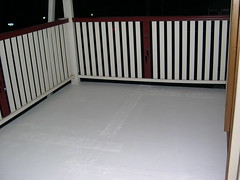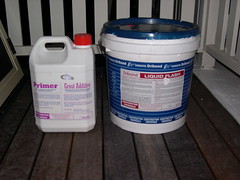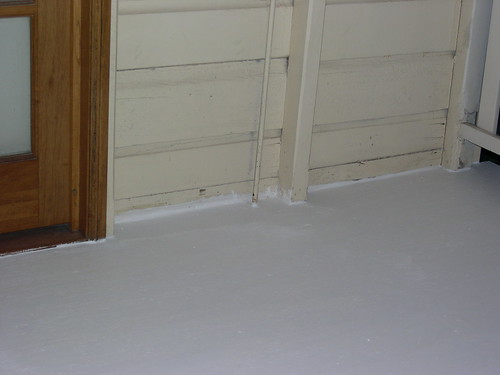 Our front veranda was originally a timber veranda. Because we are building internal rooms underneath it we are needing to waterproof the veranda so that the water can’t leak through.
Our front veranda was originally a timber veranda. Because we are building internal rooms underneath it we are needing to waterproof the veranda so that the water can’t leak through.
We had been give some pretty poor advice previously that we could keep the timber and apply a heavy duty varnish to waterproof it, or we could not bother waterproofing it and actually add what was essentially a roof under the veranda so that the water that leaked through wouldn’t reach the rooms under it. Both of those were certainly not ideal, or even viable solutions.
What we decided to do instead was to tile the front veranda in order to waterproof it.
 Before you can apply tile to the timber veranda you need to prepare it. It’s not actually the tile that provides the waterproofing, it’s the products under the tile that waterproof the veranda.
Before you can apply tile to the timber veranda you need to prepare it. It’s not actually the tile that provides the waterproofing, it’s the products under the tile that waterproof the veranda.
First thing they did was to lay some villaboard over the timber and then apply some waterproofing products to the villaboard. The villaboard provides a solid and level surface for the tile and grout to adhere to once they are laid.
On all the seams of the villaboard they used what looked like a silicone or fiberglass based tape to seal the small gaps.
The most interesting product that I watched them use was the liquid flashing. It was a very heavy and thick paste that adheres to pretty much everything that it touches.
We were very apprehensive at first about tiling over our hardwood timber veranda, but so far we have been impressed with the results.
There is more to come as the tiles get laid.
Tags: Building, Construction, Tiling, Tiles, Waterproofing

Pingback: Front Veranda Tiles Laid | Renovate Australia
WHAT THICKNESS VILLABOARD DID YOU USE
G’day Bill,
Did they grade/slope the verandah before the waterproofing went on?
If the verandah is exposed as much as it sounds like it is, I would have suggested the verandah slope away from the house. It could be done by adjusting the joists prior to the ‘villaboard’ going on. This would let any water drain away and not lay on the tiles.
If water does lay on the tiles, it will eventually stain the grout. (Much like gumleaves or tea staining on concrete). I would use a sealer on the grout joints to minimise problems.
Cheers
Mick
Thanks for the comment Mick,
They did grade most of the deck away from the house, but unfortunately one of the corners ended up higher than the house. Because of this we had water pooling at the base of the old timber wall and leaking under the house, https://www.renovateaustralia.com/2008/01/04/180mm-of-rain-in-24-hours-rain-under-the-house/.
They ended up having to install a drain at the low point in the tiles to drain the water away from the house. Not ideal, but it works …